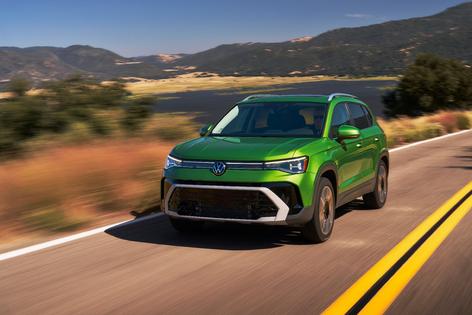Eric's Autos: 2025 Volkswagen Taos
What is the difference between Volkswagen's Taos -- and the better-known Tiguan?
About $5,000.
There's more to it than that, of course. But also less.
What It Is
The Taos is a compact crossover -- and so is the Tiguan. The latter was VW's smallest (and least expensive) crossover until the Taos slid into that slot when VW added it to the lineup in 2022.
The Taos is a little smaller -- on the outside. But it has nearly the same room on the inside. It does not offer an available third row -- but neither does the Tiguan, at least not anymore.
The Tiggy does have a larger, stronger engine -- but not much bigger (2.0 liters versus 1.5) -- and 201 horsepower (for 2025) versus 174, and the just-updated 2025 Tiggy has a larger LCD touch screen.
But the biggest difference between these two small crossovers is the price.
The Taos lists for $24,995 to start for the base S trim with front-wheel drive. The base trim Taos now comes standard with VW's digital cockpit main instrument cluster, LED projector beam headlights and a new 8-inch secondary LCD touch screen.
Opting for VW's 4-Motion all-wheel drive system bumps the MSRP up to $26,695.
A new Tiggy -- the just-updated 2025 model -- lists for $30,920 to start; with AWD, the prices goes up to $32,420.
A top-of-the-line Tiggy SE R-Line Black with AWD stickers for $38,420.
For a lot less -- $30,145 -- you could get a Taos SE Black that has similar appointments, including a full-length panorama glass sunroof, LED interior accent lighting and black-anodized wheels. Adaptive headlights and an upgraded six-speaker stereo are also standard.
A top-of-the-line Taos SEL upgrades to a digital/configurable main gauge cluster, leather upholstery and heated/cooled first-row seats and a fancier (10-color) ambient interior lighting system. AWD is standard.
This version of the Taos lists for $34,695.
What's New for 2025
The Taos receives both cosmetic and functional updates for the new model year. The standard 1.5 liter engine now makes almost as much power as the Tiggy's standard engine made last year (the output of the 2025 Tiggy's engine has been increased to make up for that) and both FWD and AWD versions now come standard with the same eight speed automatic that is also used in the Tiggy.
The interior of the 2025 Taos has also been updated with revised controls, including a larger (secondary) LCD touch screen for all trims.
What's Good
-- A lot like the Tiggy but a lot less expensive.
-- More power this year.
-- No more dual-clutch automatic in the AWD-equipped models this year.
What's Not So Good
-- Touchy (literally) touch-screen interface.
-- VW does not rate the Taos to tow ... anything.
-- Base S trim is only available in a few colors, and four of the five are shades of white, gray or black. Moss Green and Cornflower Blue are available with higher trims but cost almost $500 extra.
Under the Hood
Last year's Taos came standard with a 1.5-liter four-cylinder engine (turbocharged) that touted 158 horsepower and 28 mpg in city driving and 36 mpg on the highway (for the front-drive version; when equipped with AWD, the mileage stats decrease by 2-3 mpg).
For 2025, the Taos touts 174 horsepower -- a gain of 16 versus last year -- out of the same 1.5-liter four-cylinder engine.
Despite the power gain, the '25 Taos continues to tout about the same fuel economy as last year's model, so it retains its lower-cost-to-drive advantage over the Tiggy.
One more change for the new model year is the transmission you get. Last year's Taos came standard with an eight-speed automatic, but if you opted for AWD, you got a seven-speed dual-clutch automatic. The latter shifts faster once you're rolling but sometimes feels sluggish until you do get going, especially in a fairly heavy vehicle with not much engine.
On the Road
The Taos drives very much like the Tiggy -- and both are pleasant-to-drive small crossovers whose compact dimensions make them easy to slot into (and out of) parking spots without a lot of (if any) extraneous maneuvering.
The Taos' engine is definitely small -- but its low-end torque peak of 184 foot-pounds at 1,750 RPM (just above idle speed) makes it feel stronger than you might expect it to be when accelerating from a dead stop. It is not necessary to floor it to get it going. The now-standard eight-speed automatic helps with that, and it is one of the standout features of this small crossover on account of the fact that so many other small crossovers in this price range come standard with continuously variable transmissions that often make it feel (and sound as if) the engine is working really hard to move the vehicle.
The only thing that detracts from the driving experience is the nice-looking but sometimes exasperating-to-use LCD touch screen. The main problem with it is that the knob mounted on its upper left side to control the volume is small and stubby, so when you try to turn it, your finger may inadvertently touch the surface of the screen, which then changes the audio source to something other than what you were listening to.
The good news is that VW built in a secondary way to increase or decrease the volume using buttons on the steering wheel, so you can avoid the problem by not using the volume knob on the screen.
At the Curb
The Tiggy is longer -- by about 10 inches -- than the Taos, which is 175.9 inches long versus 186.1 inches long for the 2025 iteration of the Tiggy. But they are nonetheless very close in terms of interior space.
The Taos has 40.1 inches of front-seat legroom and 37.9 inches of backseat legroom -- and 28 cubic feet of cargo space behind its backseats. Fold those down and the space opens up to 65.9 cubic feet of total cargo-carrying capacity.
The current (2024) Tiggy has 40.2 inches of front-seat legroom, 38.7 inches of legroom in back and 65.3 cubic feet of total cargo-carrying capacity. The new-for-2025 Tiggy is about an inch longer and so may have a little more space than that. But probably not a lot more space than that. The Tiggy used to be available with a third row -- which the Taos wasn't and still isn't -- but that option has been dropped for 2025, so the Tiggy and the Taos are dead equal in terms of passenger-carrying capability.
The Rest
Like a lot of new vehicles, the Taos comes standard in just a few colors -- most of them the color of refrigerators. You have to move up to the more expensive trims to get more vibrant colors, and even then, they cost significantly extra.
In this case, just shy of $500 extra.
But don't blame VW or the other automakers that are doing this. Blame the government. The other colors are more expensive to make (due to regulatory compliance costs) and those costs get passed on to you.
The Bottom Line
The Taos is a great way to get a lot of what you'd get in a Tiggy -- for a lot less than a Tiggy costs.
========
Eric's latest book, "Doomed: Good Cars Gone Wrong!" will be available soon. To find out more about Eric and read his past columns, please visit the Creators Syndicate webpage at www.creators.com.
Copyright 2025 Creators Syndicate, Inc.








Comments